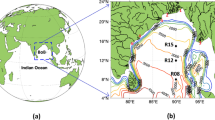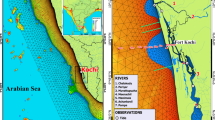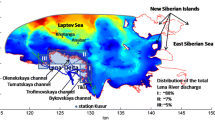Abstract
Response of Ganga-Brahmaputra river plume to wind forcing in the Bay of Bengal is studied using a numerical ocean circulation model. Four different wind forcing scenarios, namely, winds over the entire model domain, no winds anywhere over the model domain, winds over Equatorial Indian Ocean only and winds over Bay of Bengal only, are considered. Model simulations are carried out in an idealized setting where forcing from other rivers and precipitation is ignored. Despite the absence of this forcing, model captures observed phases of Ganga-Brahmaputra river plume, seasonal cycle of sea surface temperature and spatio-temporal structure of East India Coastal Current (EICC) reasonably well. Horizontal structure of the plume is investigated using surface salinity, surface currents and freshwater thickness obtained from the simulation that includes Ganga-Brahmaputra river discharge and winds over the entire model domain. The plume spreads upstream (eastward) but remains confined to the coast in northern bay during spring. During summer monsoon, plume spreads southward along the east coast of India and subsequently southeastward over the open bay and reaches the northern tip of Andaman islands by the end of October. During winter monsoon, the plume flows southward, assisted by EICC along the east coast of India and recedes northward in the central bay. In the absence of winds, the plume flows southward along the coast of India throughout the year. Equatorial winds force the plume farther (compared to no winds case) southward along the coast of India prominently in the winter monsoon. Local winds control the horizontal structure of the plume in the bay as they produce the seasonal structure that closely resembles that produced by the winds over the entire model domain. Momentum balance of the plume reveals that geostrophy controls the westward drift of the freshwater around the river mouth. Wind friction and associated Ekman flow are important in the upstream spreading of the plume during spring and in the eastward expansion over the open bay during summer monsoon.





















Similar content being viewed by others
References
Androulidakis YS, Kourafalou VH, Schiller RV (2015) Process studies on the evolution of the Mississippi River plume: impact of topography, wind and discharge conditions. Cont Shelf Res 107:33–49
Antonov J, Seidov D, Boyer T, Locarnini R, Mishonov A, Garcia H, Baranova O, Zweng M, Johnson D (2010) World Ocean Atlas 2009. In: Salinity S, Levitus E (eds) NOAA Atlas NESDIS 69, vol 2, p 184
Avicola G, Huq P (2002) Scaling analysis for the interaction between a buoyant coastal current and the continental shelf: experiments and observations. J Phys Oceanogr 32(11):3233–3248
Behara A, Vinayachandran P (2016) An OGCM study of the impact of rain and river water forcing on the Bay of Bengal. J Geophys Res Oceans 121(4):2425–2446
Benshila R, Durand F, Masson S, Bourdallé-Badie R, de Boyer Montégut C, Papa F, Madec G (2014) The upper Bay of Bengal salinity structure in a high-resolution model. Ocean Model 74:36–52
Bonjean F, Lagerloef GS (2002) Diagnostic model and analysis of the surface currents in the tropical Pacific Ocean. J Phys Oceanogr 32(10):2938–2954
Boyer TP, Antonov JI, Baranova OK, Coleman C, Garcia HE, Grodsky A, Johnson DR, Locarnini RA, Mishonov AV, O’Brien TD et al (2013) World ocean database 2013, NOAA atlas NESDIS 72. In: Levitus S, Mishonov A (eds) Technical Ed; Silver Spring, MD, p 209
Chant RJ, Glenn SM, Hunter E, Kohut J, Chen RF, Houghton RW, Bosch J, Schofield O (2008) Bulge formation of a buoyant river outflow. J Geophys Res Oceans 113(C1)
Chapman DC (1985) Numerical treatment of cross-shelf open boundaries in a barotropic coastal ocean model. J Phys Oceanogr 15(8):1060–1075
Choi BJ, Wilkin JL (2007) The effect of wind on the diersal of the Hudson River plume. J Phys Oceanogr 37(7):1878–1897
Dai A, Trenberth KE (2002) Estimates of freshwater discharge from continents: latitudinal and seasonal variations. J Hydrometeorol 3(6):660–687
Dai A, Qian T, Trenberth KE, Milliman JD (2009) Changes in continental freshwater discharge from 1948 to 2004. J Clim 22(10):2773–2792
De Boer GJ, Pietrzak JD, Winterwerp JC (2008) Using the potential energy anomaly equation to investigate tidal straining and advection of stratification in a region of freshwater influence. Ocean Model 22 (1-2):1–11
Dee DP, Uppala SM, Simmons A, Berrisford P, Poli P, Kobayashi S, Andrae U, Balmaseda M, Balsamo G, Bauer d P et al (2011) The era-interim reanalysis: configuration and performance of the data assimilation system. Q J R Meteorol Soc 137(656):553–597
Denamiel C, Budgell WP, Toumi R (2013) The Congo river plume: impact of the forcing on the far-field and near-field dynamics. J Geophys Res Oceans 118(2):964–989
Flather R (1976) A tidal model of the north-west European continental shelf. Mem Soc R Sci Liege 10:141–164
Fong DA (1998) Dynamics of freshwater plumes: observations and numerical modeling of the wind-forced response and alongshore freshwater transport. PhD thesis, Massachusetts Institute of Technology and Woods Hole Oceanographic Institution
Fong DA, Geyer WR (2001) Response of a river plume during an upwelling favorable wind event. J Geophys Res Oceans 106(C1):1067–1084
Fong DA, Geyer WR (2002) The alongshore transport of freshwater in a surface-trapped river plume. J Phys Oceanogr 32(3):957–972
Garcia Berdeal I, Hickey B, Kawase M (2002) Influence of wind stress and ambient flow on a high discharge river plume. J Geophys Res Oceans 107(C9):13–1
Garvine RW (2001) The impact of model configuration in studies of buoyant coastal discharge. J Mar Res 59(2):193–225
Gomes HR, Goes JI, Saino T (2000) Influence of physical processes and freshwater discharge on the seasonality of phytoplankton regime in the Bay of Bengal. Cont Shelf Res 20(3):313–330
Haidvogel DB, Arango HG, Hedstrom K, Beckmann A, Malanotte-Rizzoli P, Shchepetkin AF (2000) Model evaluation experiments in the North Atlantic Basin: simulations in nonlinear terrain-following coordinates. Dynam Atmos Oceans 32(3):239–281
Han W, McCreary JP (2001) Modeling salinity distributions in the indian ocean. J Geophys Res Oceans 106(C1):859–877
Hetland RD (2005) Relating river plume structure to vertical mixing. J Phys Oceanogr 35 (9):1667–1688
Hickey B, Geier S, Kachel N, MacFadyen A (2005) A bi-directional river plume: the Columbia in summer. Cont Shelf Res 25(14):1631–1656
Hill AE (1998) Buoyancy effects in coastal and shelf seas. Sea 10:21–62
Horner-Devine AR (2009) The bulge circulation in the Columbia River plume. Cont Shelf Res 29(1):234–251
Horner-Devine AR, Fong DA, Monismith SG, Maxworthy T (2006) Laboratory experiments simulating a coastal river inflow. J Fluid Mech 555:203–232
Howden SD, Murtugudde R (2001) Effects of river inputs into the Bay of Bengal. Journal of Geophysical Research:, Oceans 106(C9):19,825–19,843
Jana S, Gangopadhyay A, Chakraborty A (2015) Impact of seasonal river input on the Bay of Bengal simulation. Cont Shelf Res 104:45–62
Jensen TG (2001) Arabian Sea and Bay of Bengal exchange of salt and tracers in an ocean model. Geophys Res Lett 28(20):3967–3970
Kourafalou VH, Oey LY, Wang JD, Lee TN (1996) The fate of river discharge on the continental shelf: 1. Modeling the river plume and the inner shelf coastal current. J Geophys Res Oceans 101(C2):3415–3434
Large WG, McWilliams JC, Doney SC (1994) Oceanic vertical mixing: a review and a model with a nonlocal boundary layer parameterization. Rev Geophys 32(4):363–403
Locarnini R, Mishonov A, Antonov J, Boyer T, Garcia H, Baranova O, Zweng M, Johnson D (2010) World Ocean Atlas 2009. In: Levitus S (ed) vol 1 Temperature. NOAA Atlas NESDIS, 68 pp 184
Marchesiello P, McWilliams JC, Shchepetkin A (2001) Open boundary conditions for long-term integration of regional oceanic models. Ocean Modell 3(1-2):1–20
Mazzini PL, Barth JA, Shearman RK, Erofeev A (2014) Buoyancy-driven coastal currents off oregon during fall and winter. J Phys Oceanogr 44(11):2854–2876
McCreary J, Han W, Shankar D, Shetye S (1996) Dynamics of the east India coastal current: 2. Numerical solutions. J Geophys Res Oceans 101(C6):13,993–14,010
Milliman JD, Farnsworth KL (2013) River discharge to the coastal ocean: a global synthesis. Cambridge University Press, Cambridge
Münchow A, Garvine RW (1993) Buoyancy and wind forcing of a coastal current. J Mar Res 51(2):293–322
Oey LY, Mellor G (1993) Subtidal variability of estuarine outflow, plume, and coastal current: a model study. J Phys Oceanogr 23(1):164–171
Orlanski I (1976) A simple boundary condition for unbounded hyperbolic flows. J Comput Phys 21(3):251–269
Potemra JT, Luther ME, O’Brien JJ (1991) The seasonal circulation of the upper ocean in the Bay of Bengal. J Geophys Res Oceans 96(C7):12,667–12,683
Prasanna Kumar S, Muraleedharan P, Prasad T, Gauns M, Ramaiah N, De Souza S, Sardesai S, Madhupratap M (2002) Why is the bay of bengal less productive during summer monsoon compared to the arabian sea? Geophys Res Lett 29(24)
Richey JE, Hedges JI, Devol AH, Quay PD, Victoria R, Martinelli L, Forsberg BR (1990) Biogeochemistry of carbon in the Amazon River. Limnol Oceanogr 35(2):352–371
Schiller R, Kourafalou V, Hogan P, Walker N (2011) The dynamics of the mississippi river plume: impact of topography, wind and offshore forcing on the fate of plume waters. J Geophys Res Oceans 116(C6)
Shankar D, McCreary J, Han W, Shetye S (1996) Dynamics of the east India coastal current: 1. Analytic solutions forced by interior Ekman pumping and local alongshore winds. J Geophys Res Oceans 101 (C6):13,975–13,991
Shankar D, Vinayachandran P, Unnikrishnan A (2002) The monsoon currents in the north indian ocean. Progress Oceanogr 52(1):63–120
Shchepetkin AF, McWilliams JC (2005) The regional oceanic modeling system (ROMS): a split-explicit, free-surface, topography-following-coordinate oceanic model. Ocean Model 9(4):347– 404
Shenoi S, Shankar D, Shetye S (2002) Differences in heat budgets of the near-surface Arabian Sea and Bay of Bengal: implications for the summer monsoon. J Geophys Res Oceans 107(C6)
Shetye S, Gouveia A, Shenoi S, Sundar D, Michael G, Nampoothiri G (1993) The western boundary current of the seasonal subtropical gyre in the Bay of Bengal. J Geophys Res Oceans 98(C1):945– 954
Shetye S, Gouveia A, Shankar D, Shenoi S, Vinayachandran P, Sundar D, Michael G, Nampoothiri G (1996) Hydrography and circulation in the western Bay of Bengal during the northeast monsoon. J Geophys Res Oceans 101(C6):14,011–14,025
Shetye SR (1993) The movement and implications of the Ganges–Bramhaputra runoff on entering the. Curr Sci 64(1)
Simpson J (1981) The shelf-sea fronts: implications of their existence and behaviour. Philos Trans R Soc Lond Ser A Math Phys Sci 302(1472):531–546
Simpson J (1997) Physical processes in the rofi regime. J Marine Syst 12(1-4):3–15
Smith WH, Sandwell DT (1997) Global sea floor topography from satellite altimetry and ship depth soundings. Science 277(5334):1956–1962
Trenberth KE, Smith L, Qian T, Dai A, Fasullo J (2007) Estimates of the global water budget and its annual cycle using observational and model data. J Hydrometeorol 8(4):758–769
Varkey M, Murty V, Suryanarayana A (1997) Physical oceanography of the Bay of Bengal and Andaman Sea. Oceanogr Lit Rev 5(44):413
Vinayachandran P, Kurian J (2007) Hydrographic observations and model simulation of the Bay of Bengal freshwater plume. Deep Sea Res Part I Oceanogr Res Papers 54(4):471–486
Vinayachandran P, Mathew S (2003) Phytoplankton bloom in the Bay of Bengal during the northeast monsoon and its intensification by cyclones. Geophys Res Lett 30(11)
Vinayachandran P, Shetye S (1991) The warm pool in the Indian Ocean. Proc Indian Acad Sci-Earth Planet Sci 100(2):165–175
Vinayachandran P, Yamagata T (1998) Monsoon response of the sea around Sri Lanka: generation of thermal domesand anticyclonic vortices. J Phys Oceanogr 28(10):1946–1960
Vinayachandran P, Shetye SR, Sengupta D, Gadgil S (1996) Forcing mechanisms of the Bay of Bengal. Curr Sci 70(10):753–763
Vinayachandran P, Masumoto Y, Mikawa T, Yamagata T (1999) Intrusion of the southwest monsoon current into the Bay of Bengal. J Geophys Res Oceans 104(C5):11,077–11,085
Vinayachandran P, Murty V, Ramesh Babu V (2002) Observations of barrier layer formation in the Bay of Bengal during summer monsoon. J Geophys Res Oceans 107(C12)
Vinayachandran P, Kagimoto T, Masumoto Y, Chauhan P, Nayak S, Yamagata T (2005) Bifurcation of the east India coastal current east of Sri Lanka. Geophys Res Lett32(15)
Whitney MM, Garvine RW (2005) Wind influence on a coastal buoyant outflow. J Geophys Res Oceans 110(C3)
Whitney MM, Garvine RW (2006) Simulating the Delaware Bay buoyant outflow: comparison with observations. J Phys Oceanogr 36(1):3–21
Yankovsky AE, Hickey BM, Münchow A K (2001) Impact of variable inflow on the dynamics of a coastal buoyant plume. J Geophys Res Oceans 106(C9):19,809–19,824
Yeager S, Large W (2008) Core. 2 global air-sea flux dataset. Research data archive at the national center for atmospheric research, computational and information systems laboratory, Boulder, CO, digital media, https://doi.org/10:D6WH2N0S
Yu L, O’Brien JJ, Yang J (1991) On the remote forcing of the circulation in the Bay of Bengal. J Geophys Res Oceans 96(C11):20,449–20,454
Zhang Z, Hetland R, Zhang X (2014) Wind-modulated buoyancy circulation over the Texas-Louisiana shelf. J Geophys Res Oceans 119(9):5705–5723
Acknowledgments
The authors acknowledge Indian National Center for Ocean Information Services (INCOIS) and Ministry of Earth Sciences (MoES), Government of India, for their support for this study. P.N. Vinayachandran acknowledges partial financial support from J C Bose Fellowship, SERB, Government of India. The authors also acknowledge support from The Bay of Bengal Boundary Layer Experiment (BoBBLE), a joint MoES, India - Natural Environment Research Council (NERC), U.K. program. The BoBBLE program was funded by the MoES, Government of India, under its Monsoon Mission program administered by the Indian Institute of Tropical Meteorology, Pune. ERA-Interim reanalysis surface forcing was provided by European Centre for Medium-Range Weather Forecasts (https://www.ecmwf.int). Numerical code employed for the simulations in this study was obtained from Regional Ocean Modeling System website (http://www.myroms.org). The authors are thankful towards the research personnel at Rutgers University and University of California, Los Angeles, numerous other contributors and ROMS community for developing and maintaining ROMS code. Simulations were carried out on Mandhan, a High Performance Computing (HPC) system at the Center for Atmospheric & Oceanic Sciences, Indian Institute of Science (IISc). Mandhan was funded by the Department of Science and Technology and Divecha Center for Climate Change. A portion of the simulations were also carried out on SAHASRAT, another HPC system at the Supercomputer Education and Research Centre, IISc. We are thankful to the two anonymous reviewers for their comments and suggestions which improved the presentation of the paper.
Author information
Authors and Affiliations
Corresponding author
Ethics declarations
Conflict of interest
The authors declare that they have no conflict of interest.
Additional information
Responsible Editor: Aida Alvera-Azcárate
Publisher’s Note
Springer Nature remains neutral with regard to jurisdictional claims in published maps and institutional affiliations.
Rights and permissions
About this article
Cite this article
Pargaonkar, S.M., Vinayachandran, P.N. Wind forcing of the Ganga-Brahmaputra river plume. Ocean Dynamics 71, 125–156 (2021). https://doi.org/10.1007/s10236-020-01429-6
Received:
Accepted:
Published:
Issue Date:
DOI: https://doi.org/10.1007/s10236-020-01429-6




